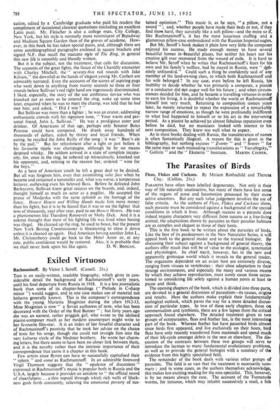The Parasites of Birds
Fleas, Flukes and Cuckoos. By Miriam Rothschild and Theresa Clay. (Collins. 21s.) PARASITES have often been labelled degenerates. Not only is their way of life naturally unattractive, but many of them have lost some of the organs of sense and locomotion possessed by their more active ancestors. But any such value judgement involves the use of false criteria. As the authors of Fleas, Flukes and Cuckoos show, each parasite must be considered against a background of the special conditions in which it lives. Although success as a parasite does indeed require characters very different from success as a free-living animal, the adaptations shown by parasites to their peculiar habitats are as complex and elegant as those of their hosts.
This is the first book to be written about the parasites of birds. Like the best of its predecessors in the New Naturalist Series, it will appeal both to the general reader and to the trained biologist. By discussing their subject against a background of general theory, the authors offer much that will be of value to the ecologist, systematist and physiologist. Its chief merit, however, lies in the new and apparently grotesque world which it reveals to the general reader. The organisms dependent on an avian host are extremely diverse, ranging from viruses to vertebrates : their close adaptation to their strange environments, and especially the many and various means by which they achieve reproduction, must surely cause those accus- tomed to considering life solely against a human norm at least to pause and think. The opening chapters of the book, which is divided into three parts, are devoted to a general discussion of parasitism—its causes, origins and results. Here the authors make explicit their fundamentally ecological outlook, which paves the way for a more detailed discus- sion of particular types. In two of these early chapters, those on commensalism and symbiosis, there are a few lapse,s from the critical approach found elsewhere. The detailed treatment given to two groups of ectoparasites, fleas and feather lice, is the most interesting part of the book. Whereas feather lice have parasited birds almost since birds first appeared, and live exclusively, on their hosts, bird fleas have only recently transferred from mammals and spend much of their life-cycle amongst debris in the nest or elsewhere. The dis- cussion of the contrasts between, these two groups will serve to introduce the layman to many fundamental evolutionary problems, as well as to provide the general biologist with a summary of the evidence from this highly specialised field.
The remainder of the book deals with various other groups of parasites. The field is so vast that the treatment is necessarily sum- mary;. and in some cases, as the authors themselves acknowledge, this makes less exciting reading for the non-specialist. This, however, is by no means always the case. The account of the Trematod; worms, for instance, which may inhabit successively a snail, a fish and a bird, and have seven different stages in their life-cycle, cannot fail to evoke wonder. The general picture of this community of weird and often macabre creatures both entertains and educates.
The book is well illustrated, so that the reader can always visualise the animals under discussion. In fact it is in some cases over- illustrated ; and the specialist may wish that an even more detailed bibliography had been substituted for some of the pictures of bird hosts, which have only a vague relevance to the text. The authors have not omitted to make use of the opportunities for the pleasantly unsophisticated strain of humour to which the subject-matter lends itself. They will certainly convert many to take a greater, and pos- sibly more kindly, interest in their subject—even though, as they say, there were no lice in the Garden of Eden. R. A. HINDE.



































 Previous page
Previous page